BY JOHAN KUGELBERG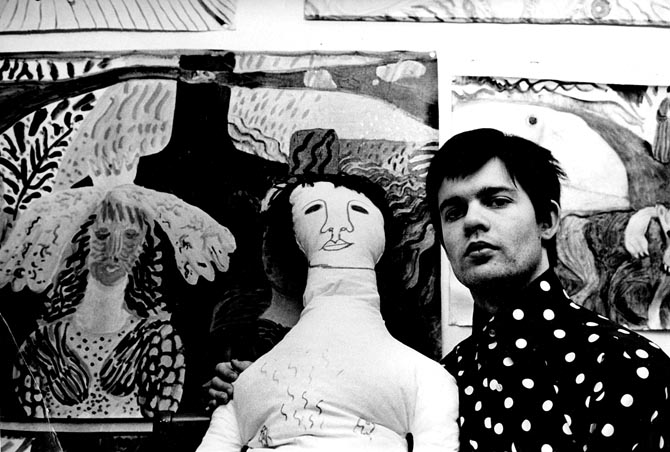 Self-portrait in my home, around 1966. Doll and paintings by Marie-Louise De Geer (now Ekman).Carl Johan De Geer is a healthy, creative and all-round delightful gentleman in his early 70s who, in rejection of his unhappy upbringing in one of Sweden’s most powerful aristocratic families, has lived his life as a perennial Swedish underground artist, working in counterpoint to the privilege of his surname.Throughout the 1960s and 70s, Carl Johan De Geer and his then wife Marie-Louise (now head of the Swedish National Dramatic Theatre) were at the epicentre of a crowd that included some of the dominant movers and shakers of Swedish society, culture and politics at the time. Carl Johan always had his Leica M4 at hand, constantly snapping away at his surroundings, capturing the extraordinary melancholic vibrancy of times and ways now long gone, and taking intimate portraits of his friends—people like satirical cartoonist Lars Hillersberg, artists Lena Svedberg and Öyvind Fahlström, psych legend Bo Anders Persson, cartoonist Jan Lööf and mainstream newspaper critic Leif Nylén. Together, they published underground magazines, organized demonstrations and executed street art. They were bastions of Swedish originality that continue to reverberate to this day.Being a long time fan of De Geer, I found it strange that no one had done anything major with these images outside Sweden. Carl Johan De Geer’s impressive, encompassing photographic archive of the life curve of outsider life in a small, privileged nation almost half a century ago is superb, instinctive and created completely without labour or pretence. So, this year, I took it upon myself to help issue three publications featuring his pictures,Galleri Karlsson 1968(Ectoplasm),The Camera As Consolation(Boo-Hooray) andLong Live the Large Family(Dashwood), to coincide with his two recent exhibitions in Stockholm and New York. Prior to that, his images had only ever been published in the hyper-rare photo bookMed Kameran Som Tröst, issued in Sweden in 1980.These are some of my favourite images of his, printed here alongside descriptions written by Carl Johan De Geer. It should also be mentioned that these pictures aren’t taken from negatives, but from actual prints Carl Johan de Geer used as work samples, or that were sold as postcards (back when you could get gelatin silver 4x6 prints made for pennies), and a handful were used as exhibition prints. I like the visible scratches, fades and imperfections, the wabi-sabi, and the vintage nature of these prints. They reflect Carl Johan De Geer’s sacred ability to turn the grit of everyday life into something beautiful. The rumpled post-sex sheets, the crumbling façade of a building in its final fleeting moments before demolition, and the interiors of said building, where 1960s Stockholm bohos were making love and raising families, paying rock-bottom rent. They give us a glimpse of a Sweden inhabited by people whose life experience was impregnated with an otherness that juxtaposes most common notions of Swedes and Sweden.Staring ourselves blind at the stylish swagger of 1960s counter-culture can feed inactivity, as everything seems to already have been sung, spoken, tap-danced, ukulele’d or performance-arted. It leaves us who missed out on those groovy times with a vague sense of living in an age post the end of the world. But as we still haven’t been able to completely depart the 20th century, and the rapidly departing baby-boomers continue the life-lie that only certain years of this mortal coil truly mattered, we must study these remains of the 60s with great care.For more information on Carl Johan De Geer’s snaps, visit boo-hooray.com
Self-portrait in my home, around 1966. Doll and paintings by Marie-Louise De Geer (now Ekman).Carl Johan De Geer is a healthy, creative and all-round delightful gentleman in his early 70s who, in rejection of his unhappy upbringing in one of Sweden’s most powerful aristocratic families, has lived his life as a perennial Swedish underground artist, working in counterpoint to the privilege of his surname.Throughout the 1960s and 70s, Carl Johan De Geer and his then wife Marie-Louise (now head of the Swedish National Dramatic Theatre) were at the epicentre of a crowd that included some of the dominant movers and shakers of Swedish society, culture and politics at the time. Carl Johan always had his Leica M4 at hand, constantly snapping away at his surroundings, capturing the extraordinary melancholic vibrancy of times and ways now long gone, and taking intimate portraits of his friends—people like satirical cartoonist Lars Hillersberg, artists Lena Svedberg and Öyvind Fahlström, psych legend Bo Anders Persson, cartoonist Jan Lööf and mainstream newspaper critic Leif Nylén. Together, they published underground magazines, organized demonstrations and executed street art. They were bastions of Swedish originality that continue to reverberate to this day.Being a long time fan of De Geer, I found it strange that no one had done anything major with these images outside Sweden. Carl Johan De Geer’s impressive, encompassing photographic archive of the life curve of outsider life in a small, privileged nation almost half a century ago is superb, instinctive and created completely without labour or pretence. So, this year, I took it upon myself to help issue three publications featuring his pictures,Galleri Karlsson 1968(Ectoplasm),The Camera As Consolation(Boo-Hooray) andLong Live the Large Family(Dashwood), to coincide with his two recent exhibitions in Stockholm and New York. Prior to that, his images had only ever been published in the hyper-rare photo bookMed Kameran Som Tröst, issued in Sweden in 1980.These are some of my favourite images of his, printed here alongside descriptions written by Carl Johan De Geer. It should also be mentioned that these pictures aren’t taken from negatives, but from actual prints Carl Johan de Geer used as work samples, or that were sold as postcards (back when you could get gelatin silver 4x6 prints made for pennies), and a handful were used as exhibition prints. I like the visible scratches, fades and imperfections, the wabi-sabi, and the vintage nature of these prints. They reflect Carl Johan De Geer’s sacred ability to turn the grit of everyday life into something beautiful. The rumpled post-sex sheets, the crumbling façade of a building in its final fleeting moments before demolition, and the interiors of said building, where 1960s Stockholm bohos were making love and raising families, paying rock-bottom rent. They give us a glimpse of a Sweden inhabited by people whose life experience was impregnated with an otherness that juxtaposes most common notions of Swedes and Sweden.Staring ourselves blind at the stylish swagger of 1960s counter-culture can feed inactivity, as everything seems to already have been sung, spoken, tap-danced, ukulele’d or performance-arted. It leaves us who missed out on those groovy times with a vague sense of living in an age post the end of the world. But as we still haven’t been able to completely depart the 20th century, and the rapidly departing baby-boomers continue the life-lie that only certain years of this mortal coil truly mattered, we must study these remains of the 60s with great care.For more information on Carl Johan De Geer’s snaps, visit boo-hooray.com This picture, called The Double Bottomed Pacifism, was taken in the De Geer home in 1967. It’s of well-known media personalities Lars Svanberg and Håkan Alexandersson, in a humorous fight. Both have now passed away.
This picture, called The Double Bottomed Pacifism, was taken in the De Geer home in 1967. It’s of well-known media personalities Lars Svanberg and Håkan Alexandersson, in a humorous fight. Both have now passed away. Gärdesfesten, 1970. In the now I mourn the dead.
Gärdesfesten, 1970. In the now I mourn the dead. Picnic in Drottningholmsparken in Stockholm, around 1972.
Picnic in Drottningholmsparken in Stockholm, around 1972. A trip with the then Madame De Geer around 1966.
A trip with the then Madame De Geer around 1966. The band Elektriska Linden in a stage design of mine at Filmhuset in Stockholm, 1975. I played the trombone (there’s an LP) and took the picture with my Leica on a tripod using the self-timer. I’m the chef guy in the middle, and had to rush there in the 10 seconds you get.
The band Elektriska Linden in a stage design of mine at Filmhuset in Stockholm, 1975. I played the trombone (there’s an LP) and took the picture with my Leica on a tripod using the self-timer. I’m the chef guy in the middle, and had to rush there in the 10 seconds you get. This photo of Annikka Nuora and her child was taken during the recording of Marie-Louise Ekman’s short film Sagan om den lilla flickan och den stora kärleken, 1985.
This photo of Annikka Nuora and her child was taken during the recording of Marie-Louise Ekman’s short film Sagan om den lilla flickan och den stora kärleken, 1985. This was taken at a TV recording directed by Marie-Louise Ekman, around 1980. I can’t remember the name of the production, but this girl was a cat and I played a dog.
This was taken at a TV recording directed by Marie-Louise Ekman, around 1980. I can’t remember the name of the production, but this girl was a cat and I played a dog. This picture was taken during the recording of the TV series Tårtan, 1972. It's of the wig and teeth of Janos, one of the main characters, and the fake nose and glasses of Frasse, another character.
This picture was taken during the recording of the TV series Tårtan, 1972. It's of the wig and teeth of Janos, one of the main characters, and the fake nose and glasses of Frasse, another character. The gerbil Hans from the TV series Doktor Krall, 1974. It was a difficult portrait to take because the animal kept jumping away. I used a flash and an old 90 mm Leica lens from the 50s to get an old-fashioned portrait style, and was shouting really loudly to paralyze the rodent during the second that was needed.
The gerbil Hans from the TV series Doktor Krall, 1974. It was a difficult portrait to take because the animal kept jumping away. I used a flash and an old 90 mm Leica lens from the 50s to get an old-fashioned portrait style, and was shouting really loudly to paralyze the rodent during the second that was needed. Gärdesfesten, an alternative music festival in Stockholm, June 1970.
Gärdesfesten, an alternative music festival in Stockholm, June 1970. A sailing demonstration outside Stockholm’s Royal Palace during the recording of Öyvind Fahlström’s film Du gamla, du fria, 1970. On the sail is a defamatory drawing of then Liberal Party leader Sven Wedén, who owned a tongs factory.
A sailing demonstration outside Stockholm’s Royal Palace during the recording of Öyvind Fahlström’s film Du gamla, du fria, 1970. On the sail is a defamatory drawing of then Liberal Party leader Sven Wedén, who owned a tongs factory. I took this at the recording of the TV series Tårtan, 1972. That’s me in the mirror to the left, and Jan Lööf to the right.
I took this at the recording of the TV series Tårtan, 1972. That’s me in the mirror to the left, and Jan Lööf to the right. The student union occupation in 1968, with the media elite from Swedish Channel 2 in the foreground (Ingrid Dahlberg, Birgitta Bergmark, Staffan Lamm).
The student union occupation in 1968, with the media elite from Swedish Channel 2 in the foreground (Ingrid Dahlberg, Birgitta Bergmark, Staffan Lamm). Variety ballet dancers backstage around 1980.
Variety ballet dancers backstage around 1980. Musician Bo Anders Persson (Träd, Gräs och Stenar and Persson Sound) discussing Gärdesfesten’s illegality with the police.
Musician Bo Anders Persson (Träd, Gräs och Stenar and Persson Sound) discussing Gärdesfesten’s illegality with the police. My friend Arslan, around 1967.
My friend Arslan, around 1967.

Advertisement
Advertisement
Advertisement









Advertisement






